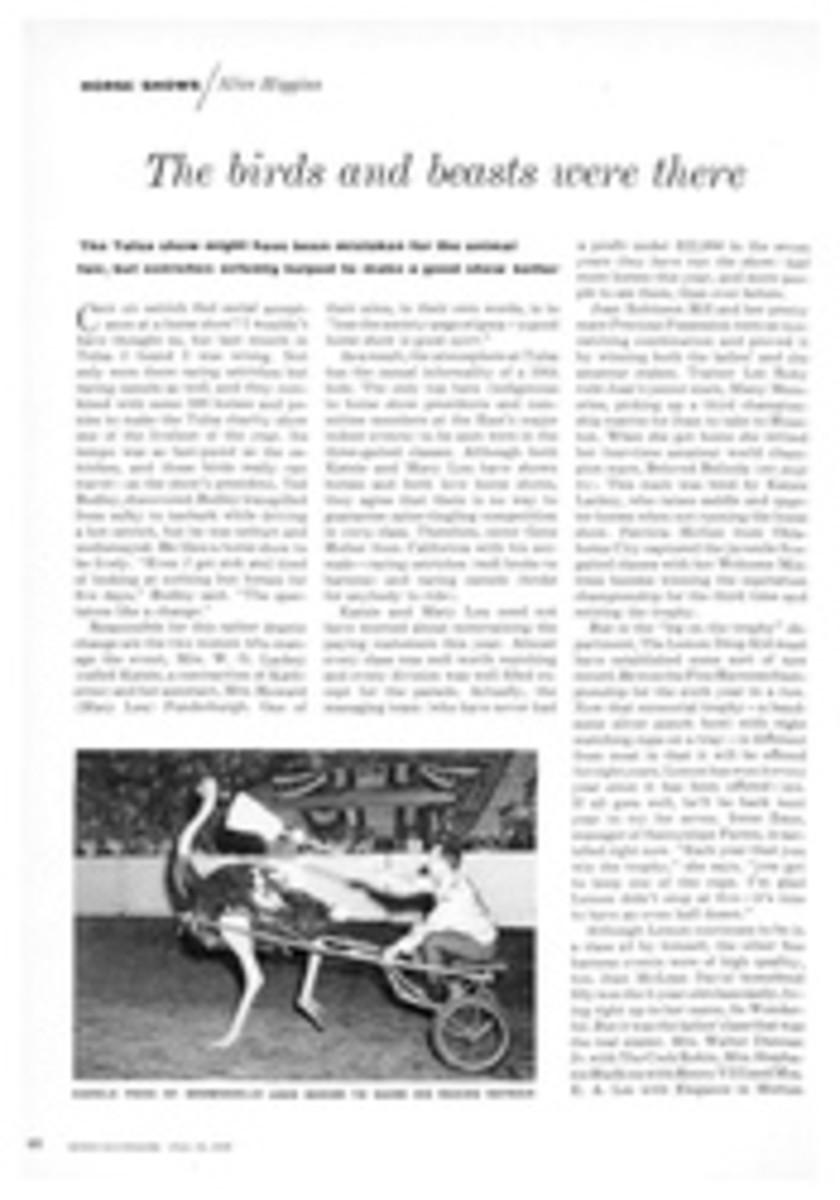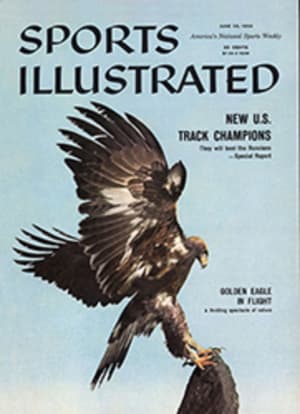
THE TRAILING HOUNDS
A fortnight ago Sports Illustrated introduced a four-part series on field-training the sporting breeds with instruction on how to train the flushing spaniels. Now, on the following pages, the lessons continue with an explanation of the techniques of preparing trailing hounds for the chase. The five dogs shown above are the most popular trailing hounds in America today; but in addition to these dogs, countless mixed strains are used for tracking. Most often, they follow rabbits, but they also trail raccoons, foxes, deer and sometimes even people. Regardless of quarry, all of the trailing hounds share one thing in common—an extraordinary ability to follow a ground trail by scent. They must be taught, nonetheless, to concentrate their superior ability on a single scent and to follow it without interruption no matter what other scents may cross the trail. This is the basis of all hound training, whether the dog be a basset after a rabbit or a bloodhound helping rescue a lost child. The desire to hunt is a powerful instinct in all hounds, and if the trainer has patience even the most sluggish family pet can become a good trailer. In fact, you will probably find that your dog is a better companion at home when he has learned to be a companion afield.
Schooling the bloodhound
Teaching a bloodhound to follow a trail is informal, fun and the foundation of most trailing-hound training. Since a bloodhound is almost always used to track people, you will need the cooperation of a friend. You will also need a harness (made to order for $7.50) and a sturdy lead, both of which are necessary for all future tracking. To begin the training, have your friend walk off a short, easy trail, ending behind a bush or tree. Make it about 150 yards for a starter, and agree in advance on its course. When your friend is out of sight, let the dog sniff an item of his clothing—preferably a sock. Then have the dog sniff the place on the ground where the trail begins. When a bloodhound puts his nose to the ground, the loose folds of skin around his head sag forward, forming a cup to trap scent. If you pull the skin on his neck forward (left), you will help him get a better sniff. Once he associates the garment with the ground scent, his natural instinct will be to follow the trail. Encourage him with your voice. If the dog wanders from the trail or loses interest in it, let him sniff the clothing again. Keep a firm grip on the lead at all times and move at the dog's pace so he doesn't think you are pulling him back. When he comes to the end of the trail, the dog should leap up on his quarry to indicate he has found the person he was tracking. Most bloodhounds will do this naturally. If yours doesn't, encourage him by having your friend give him a tidbit as soon as the dog reaches him. Take the dog out as often as possible, each time increasing the length and difficulty of the trail. And be patient with his mistakes. The average bloodhound needs at least six months of regular training to follow a trail without error.
Teaching the game hounds
Like the bloodhound, the other trailing hounds—beagles, bassets, dachshunds and coonhounds—must learn to concentrate on a single track before they are ready to go on a real hunt. And since these other breeds are small game hunters, a game trail instead of a human trail is used in training them. For this early training, it will be much easier for both you and the dog if you make an artificial trail, which you do by saturating a bag of sawdust with commercial game scent ($3) and dragging it about 100 yards. Then, with the dog on lead, take him to the place where the trail starts. When he locates the scent, encourage him to follow it and correct him if he wanders. At the end of the trail, reward him with praise and a tidbit. When he has learned to follow an easy trail, remove the lead and drag the scent through brush and briers so he gets used to more difficult routes. Spend at least two months on this stage of training.
First encounter with game
As soon as the dog can follow an artificial trail, he is ready for live game. At this stage the type of game—regardless of what the dog will eventually hunt—is not important as long as it leaves a simple, obvious trail. A rabbit from a pet shop is easy to care for and slow enough for a young dog to keep up with. This training should take place in an enclosed area so both the game and the dog are under control. Let the dog sniff the rabbit while a friend holds it. Then take the dog out of sight and release the rabbit. Unleash the dog and encourage him to find and follow the rabbit's trail. An older dog can help in this training by leading the way. In any case, stay close behind so you can separate dogs and rabbit if necessary. Take the dog out with the rabbit for about a week and keep the sessions short so the dog will not lose his enthusiasm.
First time in the field
The most challenging phase of hound training occurs when you go afield after wild game. Now the trail may lead anywhere; it may be old or it may not exist at all. But the measure of a good trailing hound is experience, and the only way he will gain it is by hunting as often as possible. Again, an older dog can be of help during these sessions because the young dog will follow him and learn by imitation. Whether you take the dog afield alone or with another dog, however, always take him on lead so that he knows you are the boss. When you reach the hunting area, release the dog and encourage him to start hunting by talking to him as you walk through the woods. Many people find the chase itself so enjoyable that they never shoot over their trailing hounds. Nevertheless, it is a good idea to acquaint your dog with gunfire so that he will not be frightened by it. You can do this by carrying along a shotgun (a .410 is better than a larger gauge at first because it makes less noise) and firing it from time to time when the dog is actually on a trail and at least 50 yards from you. In areas where game is scarce or cover is dense, beat the bushes with a stick as you walk along. Rabbits and other small game often sit tight at the approach of danger and can sometimes be routed out of hiding by such action. And always be on the alert for signs of game. You may see an animal take off before the dog is able to scent it. If you do, call him back to you and help him locate the trail.
Running a fresh trail
When you locate a fresh game trail, the pup will probably bound off on the scent, particularly if there is an older dog along. If he does not, start him on the trail by pointing out the way You will know he is on scent when you hear the deep-throated baying that all game hounds instinctively sound when they hit a fresh track. This is the climax of the chase and the reward for the many hours of training. For whether you hunt with a gun or for the chase alone, the musical cry of a tracker closing in on his quarry is one of the most exciting sounds in the field.
ILLUSTRATION
BURT SILVERMAN
PHOTO
BLOODHOUND
BLACK AND TAN
BASSET HOUND
BEAGLE
DACHSHUND
ILLUSTRATION
BURT SILVERMAN
Bloodhound gets the scent by sniffing clothing of his quarry.
ILLUSTRATION
BURT SILVERMAN
Hound associates scent of clothing with ground trail.
ILLUSTRATION
BURT SILVERMAN
Trainer stays close behind as the dog takes off on the trail.
ILLUSTRATION
BURT SILVERMAN
Hound follows the scent to hiding place behind bush.
ILLUSTRATION
BURT SILVERMAN
Dog jumps up on quarry to show positive identification.
ILLUSTRATION
BURT SILVERMAN
Make artificial game trail by dragging bag of scent.
ILLUSTRATION
BURT SILVERMAN
Take dog on lead to place where artificial trail begins.
ILLUSTRATION
BURT SILVERMAN
Let dog set the pace as he follows scent along trail.
ILLUSTRATION
BURT SILVERMAN
Dog sniffs rabbit to become acquainted with the scent.
ILLUSTRATION
BURT SILVERMAN
Rabbit is released and dog sets out on chase.
ILLUSTRATION
BURT SILVERMAN
On first hunt, bring an older dog along as guide for pup.
ILLUSTRATION
BURT SILVERMAN
Try to keep close to dog and use light-gauge gun.
ILLUSTRATION
BURT SILVERMAN
Beat bushes with a stick to drive out hidden game.
ILLUSTRATION
BURT SILVERMAN
Young dog takes lead from older dog in following trail.
ILLUSTRATION
BURT SILVERMAN
Trainer shows dog place where game trail begins.
ILLUSTRATION
BURT SILVERMAN
Dogs leave the field on lead at end of day's hunt.
FRED HUYLER
Ever since Fred Huyler was given a beagle as a pet in 1886, hounds and hunting have been his career. As a young man he was hired to train hounds at Hamilton Farms in Gladstone, N.J. Since then, the number of dogs he has trained and field trials he has run cannot be counted. On the following pages, Huyler shares the lessons of 70 years afield in teaching you how to train the trailing hounds.
THE RETRIEVERS
In the July 13 issue James Cowie of Commack, N.Y. draws upon a lifetime of waterfowl shooting and gun dog training to tell you how to train the retrieving breeds for the field.

